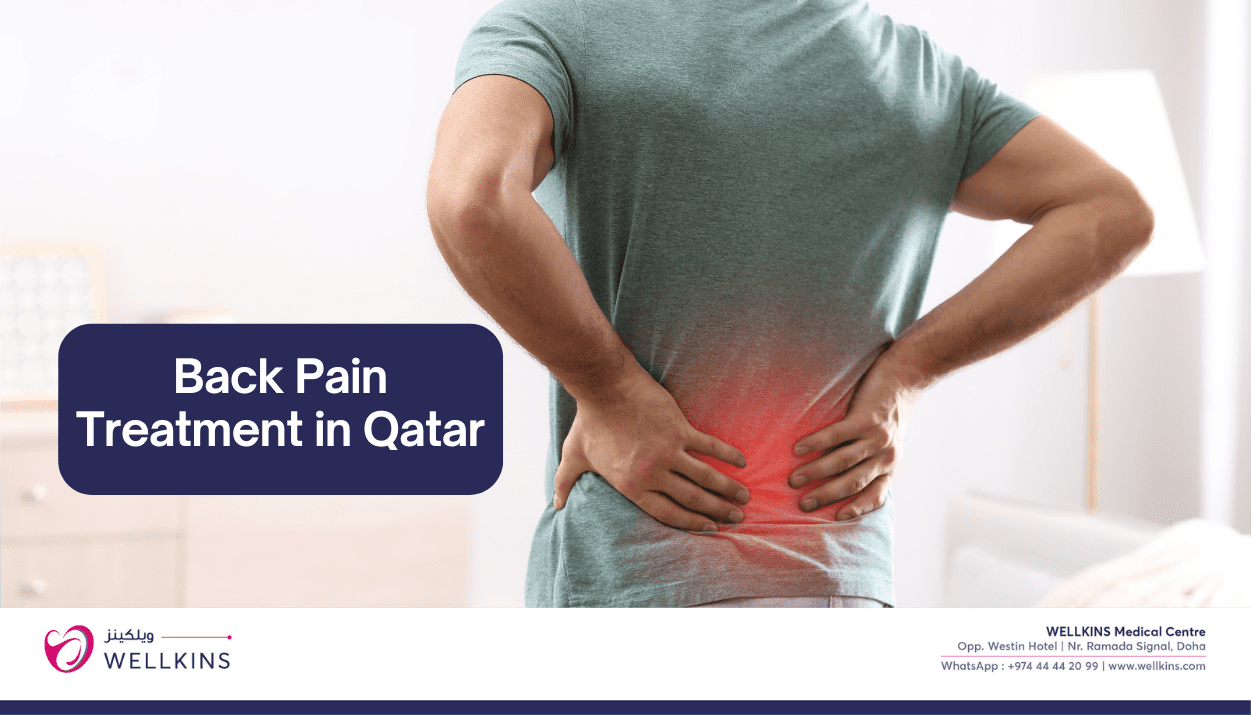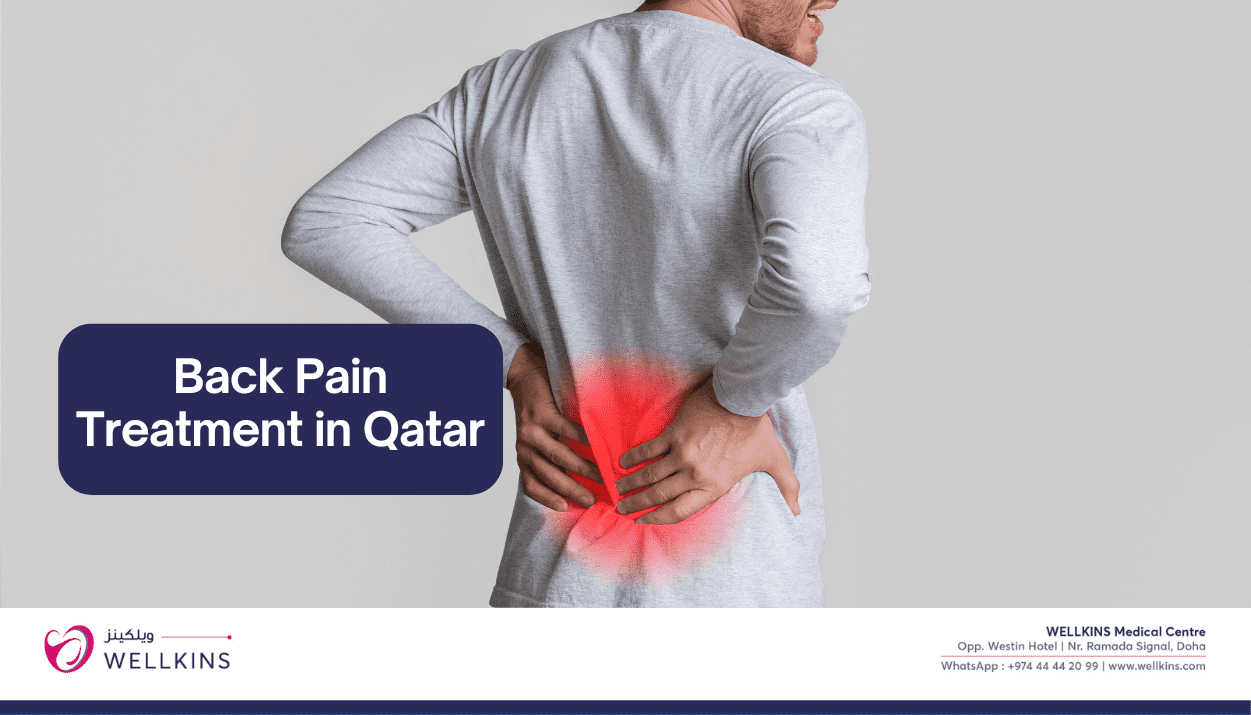Author: Dr.Reneesh (Consultant Orthopedic Surgeon – WELLKINS Medical Centre)
If you’ve ever groaned, “Oh, my aching back”, you are not alone. Back pain is one of humanity’s most frequent complaints. About nine out of ten adults experience back pain at some point in their life, and five out of ten working adults have back pain every year. Back pain is the pain felt in the back that usually originates from the muscles, nerves, bones, joints, or other structures in the spine.
Back pain may have a sudden onset or can be a chronic pain; it can be constant or intermittent, stay in one place or radiate to other areas. It may be a dull ache, or a sharp or piercing or burning sensation. The pain may radiate into the arms and hands as well as the legs or feet, and may include symptoms other than pain. These symptoms may include tingling, weakness, or numbness. Acute back pain comes on suddenly and usually lasts from a few days to a few weeks. Back pain is called chronic if it lasts for more than three months.
Most people experience low back pain at least once during their lives. Back pain is one of the most common reasons people go to the doctor or miss work. On the bright side, you can take measures to prevent or lessen most back pain episodes. If prevention fails, simple home treatment and proper body mechanics will often heal your back within a few weeks and keep it functional for the long haul.
Treatment for back pain depends on what kind of pain you have, and what is causing it. It may include hot or cold packs, exercise, medicines, injections, complementary and alternative treatments, and sometimes surgery.
Symptoms of back pain may include:
- Muscle ache
- Shooting or stabbing pain
- Pain that radiates down your leg
- Limited flexibility or range of motion of the back
- Inability to stand up straight
When to see a doctor?
Most back pain gradually improves with home treatment and self-care. Although the pain may take several weeks to disappear completely, you should notice some improvement within the first 72 hours of self-care. If not, see your doctor.
In rare cases, back pain can signal a serious medical problem. Seek immediate care if your back ache causes new bowel or bladder problems, if it is associated with pain or throbbing (pulsation) in the abdomen, fever, follows a fall – blow to your back or other injury.
Contact a doctor if your back pain:
- Is constant or intense, especially at night or when you lie down
- Spreads down one or both legs, especially if the pain extends below the knee
- Causes weakness, numbness or tingling in one or both legs
- Is accompanied by unexplained weight loss
- Occurs with swelling or redness on your back
Also, see your doctor if you start having back pain for the first time after age 50, or if you have a history of cancer, osteoporosis, steroid use, or drug or alcohol abuse.
Back pain is one of the most common reasons people go to the doctor or miss work. On the bright side, you can take measures to prevent or lessen most back pain episodes. If prevention fails, simple home treatment and proper body mechanics will often heal your back within a few weeks and keep it functional for the long haul.
The reasons behind experiencing back pain
Back pain often develops without a specific cause that your doctor can identify with a test or imaging study. Conditions commonly linked to back pain include muscle or ligament strain, bulging or ruptured disks, arthritis, skeletal irregularities and osteoporosis.

Preparing for your doctor’s appointment
If you have back pain that’s lasted for at least a few days and isn’t improving, make an appointment with your family doctor or primary care provider.
What you can do
- Write down key personal information, including any mental or emotional stressors in your life.
- Make a list of your key medical information, including any conditions for which you’re being treated and the names of any medications you’re taking.
- Note any recent injuries that may have damaged your back.
- Take a family member or friend along, someone who accompanies you may remember something that you missed or forgot.
- Write down questions to ask your doctor.
For back pain, some basic questions to ask your doctor include:
- What is the most likely cause of my back pain?
- Do I need any diagnostic tests?
- What treatment approach do you recommend?
- If you’re recommending medications, what are the possible side effects?
- How can I best manage my other medical conditions together?
- How long will I need treatment?
- What self-care measures should I be taking?
- Is there anything else I can do to help prevent a recurrence of back pain?
What to expect from your doctor? Your doctor may ask:
- When did you first begin having back pain?
- How often do you have back pain?
- How much is your pain limiting your ability to function?
- Do you have any other signs or symptoms in addition to back pain?
- Do you do heavy physical work?
- Do you exercise regularly? If yes, with what types of activities?
- How often do you feel blue or depressed?
- How much stress or conflict do you experience on a daily basis?
- Do you sleep well most of the time?
- What treatments or self-care measures have you tried so far? Has anything helped?
- Are you currently being treated or have you recently been treated for any other medical conditions?
Tests & Diagnosis For Back Pain
Diagnostic tests aren’t usually necessary to confirm the cause of your back pain. However, if you do see your doctor for back pain, he or she will examine your back and assess your ability to sit, stand, walk and lift your legs. Your doctor may also test your reflexes with a rubber reflex hammer. If there is reason to suspect a specific condition may be causing your back pain, your doctor may order one or more tests, X-ray, Magnetic resonance imaging (MRI) or computerized tomography (CT) scans and Bone scan.
Treatments For Back Pain
Most back pain gets better with a few weeks of home treatment and careful attention. Over-the-counter pain relievers may be all that you need to improve your pain. A short period of bed rest is OK, but more than a couple of days actually does more harm than good.
- Medications: Your doctor is likely to recommend Nonsteroidal anti-inflammatory drugs. Take these medications as directed by your doctor, overuse can cause serious side effects. If mild to moderate back pain doesn’t get better with over-the-counter NSAIDS, your doctor may also prescribe a muscle relaxant.
- Education: There’s no commonly accepted program to teach people with back pain how to manage the condition effectively. Education may be a class or a talk with your doctor. The education emphasizes the importance of staying active, reducing stress and worry, and teaching ways to avoid future injury. The doctor will also explain that your back pain may recur, especially during the first year after the initial episode.
- Physical therapy and exercise: A physical therapist can apply a variety of treatments, such as heat, ultrasound, electrical stimulation and muscle-release techniques, to your back muscles and soft tissues to reduce pain. As pain improves, the therapist will teach you specific exercises that will help strengthen your back.
- Surgery: If you have progressive muscle weakness caused by nerve compression and Bowel and Bladder involvement, you may benefit from surgical intervention. Otherwise, surgery usually is reserved for pain related to structural anatomical problems that haven’t responded to intensive conservative therapy measures.
The prevention and relief of back pain
- Exercise: Regular low-impact aerobics activities such as walking and swimming, those that don’t strain or jolt your back.
- Build muscle strength and flexibility: Abdominal and back muscle exercises help condition these muscles so that they work together like a natural corset for your back.
- Maintain a healthy weight: Being overweight puts strain on your back muscles.
- Stand, sit and lift smart: Maintain a neutral pelvic position. If you must stand for long periods of time, alternate placing your feet on a low footstool to take some of the load off your lower back. Choose a seat with good lower back support, arm rests and a swivel base. Consider placing a pillow or rolled towel in the small of your back to maintain its normal curve. Keep your back straight and bend only at the knees. Hold the load close to your body. Avoid lifting and twisting simultaneously. Find a lifting partner if the object is heavy or awkward.







